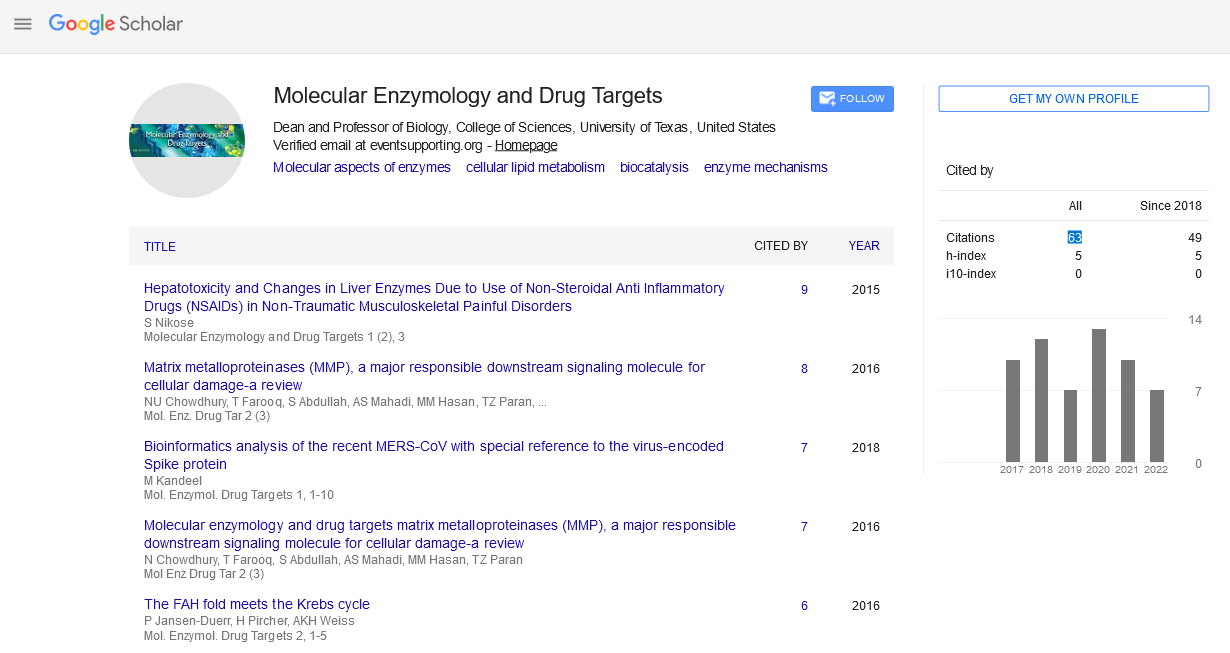Abstract
Traditional biological research and natural product drug discovery to a systematic operation in genomics and target-specific drug design and selection. Small, cell- permeable and target-specific chemical ligands are particularly useful in systematic genomic approaches to study biological questions. On the other hand, genomic sequence information, comparative and structural genomics, when combined with the cutting edge technologies in synthetic chemistry and ligand screening/ identification, provide a powerful way to produce target-specific and/or function- specific chemical ligands and drugs. Chemical genomics or chemo genomics is a new term that describes the development of target-specific chemical ligands and the use of such chemical ligands to globally study gene and protein functions. We anticipate that chemical genomics plays a critical role in the genomic age of biological research and drug discovery.
Keywords
Chemo genomics; Drug; Mutagen
Introduction
The turn of this century marks significant progress in biology. We
have advanced from knowing very little about our genetic makeup
to now having complete knowledge of our genome [1].Essential to
process enormous genomic information. In this regard, chemical
ligand-based approaches are especially powerful toward global
understanding of gene and protein functions. Presently, the
process of discovering target-specific chemical ligands using
synthetic chemistry has become a practical means, which largely
attributes to technological advances in target specific and diversitybased
organic synthesis. Since the seminal study of pea genetics
by Mendal in 1865, genetic analysis has been the benchmark for
understanding gene or protein functions. In classical genetics or
forward genetics, the genomic DNA of a model organism or cell
is randomly mutagenized to generate large numbers of mutants,
which are screened for a desirable phenotype or trait, such as
alteration in growth, appearance or behavior. The phenotypes
are then used to identify the responsible genes [2]. However,
these approaches require complex genetic manipulation, which
is often tedious and time-consuming. Moreover, they are based
on blockage of steps leading to translation, which make them
ineffective toward studying proteins with long half-lives. They can
rapidly penetrate into the cells, bind to their target proteins and
create loss-of-function (or gain-of-function) phenotypes. In recent
years, drug discovery has shifted from predominantly screening
for natural products to target oriented synthesis/screening of
chemical ligands, which in large part is due to the realization
that targeting the disease-causing genes/proteins and biological
pathways is fundamentally important for successful development
of highly effective drugs .In a typical chemical genetics approach,
a cell permeable, target-specific chemical ligand is added to the
cells of interest, which binds to and causes loss-of-function or gain-of-function of its protein target. Chemical ligands may bind
to the enzyme’s catalytic site by mimicking natural substrates of
the enzyme, as exemplified by the drug lovastatin/mevinolin.
Description
Chemical ligands can be easily administrated at any time during
the cell cycle or developmental stages, and any desired location
of the cell or organism [3]. Therefore, chemical ligands pose
unparalleled temporal and spatial control over their protein
targets. Classical examples include the proteasome inhibitor
lactacystin and the immunosuppressant rapamycin (Schreiber
1991). Both drugs are microbial natural products that inhibit
cell proliferation and interfere with normal cellular functions
(Martel et al. 1977; Omura et al. 1991). Lactacystin specifically binds to and inhibits the 20S proteasome (Fenteany et al. 1995).
Knowledge of the target proteins has advanced chemical genetics
to a stage that parallels the classical reverse genetics, i.e., the use
of the compound to study the biological functions of the drug
target protein. For example, as a result of the use of lactacystin,
the proteasome is found to be important for diverse biological
pathways and processes, including antigen presentation, cell
cycle control and cell fate determination (Fenteany and Schreiber
1998). An alternative approach has been developed to use a
combination of protein and chemical engineering to modulate
the functions of proteins and genes (Bishop et al. 2000) [4].
An early example of this is the use of a synthetic chemical
dimerizer, called FK1012 that is derived from FK506 with two
FKBP12-binding moieties. Only the engineered enzyme, but not
the native enzyme modified ligand can recognize the modified
ligand. Belshaw et al. first described this approach in the study of
cyclophilin and its ligand cyclosporin A. Target-specific chemical
ligands are pivotal for studying biological questions and drug
development. Natural products have been traditionally the source
for novel ligand screening and discovery, primarily because of
their unparalleled range in mode of action and chemical diversity.
Combinatorial organic synthesis has increasingly been used to
generate small molecule libraries for ligand screening and drug
discovery. It stems from the original solid-phase oligonucleotide
and peptide synthesis, which provides a way to synthesize and
purify peptides with defined sequences. Another concept in
chemical ligand synthesis that has emerged in recent years is
to change the chirality of the compounds. Biological molecules
often contain chiral or asymmetric carbon atoms, at which the
carbon atom is bonded to four different moieties. Such molecules
exist in two forms, known as enantiomers. . To develop successful
lead compounds against diverse protein targets, a designer
approach is needed. This is when the in silico approach comes
into play, owning to significant advances in computational power
and the development of artificial intelligence. They can be readily
integrated into the existing genomic approaches and tools. A
significant advantage of using chemical ligands is that there
is no limit on the developmental stage of the organisms or the
conditions the cells and organisms are in. In addition, chemical
ligands can be easily used in high throughput analyses. . It is now
possible to simultaneously compare the drug-induced profiles
with the existing gene expression databases, thereby identifying
relevant biological pathway or functions for the drug target [5].
Proteomics or protein profiling is a field dedicated to studying
the complete protein complement of a cell, tissue or organism.
Posttranslational modifications play crucial roles in regulation of
diverse cellular processes such as signal transduction, cell cycle
control, development, cytoskeleton networks and metabolism.
Acknowledgement
None
Conflict of interest
No conflict of interest





